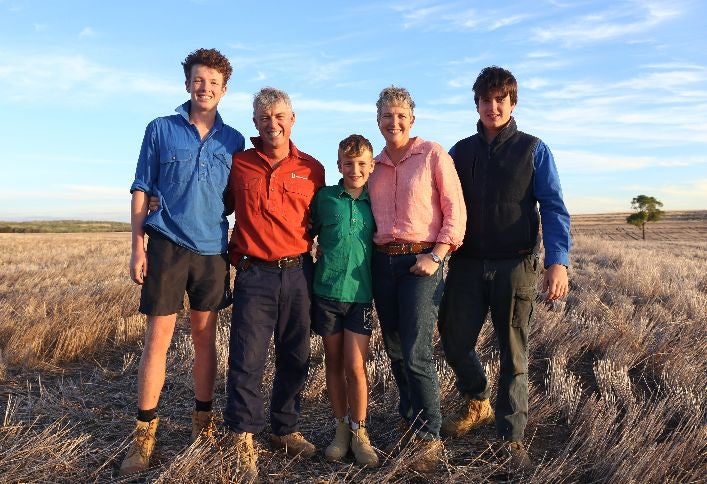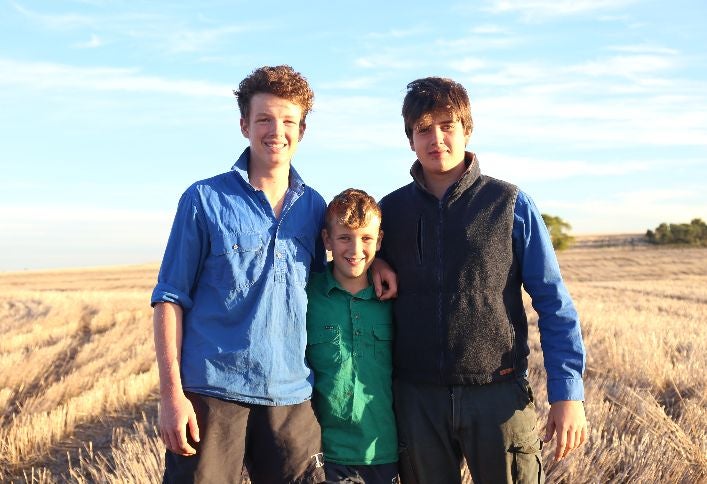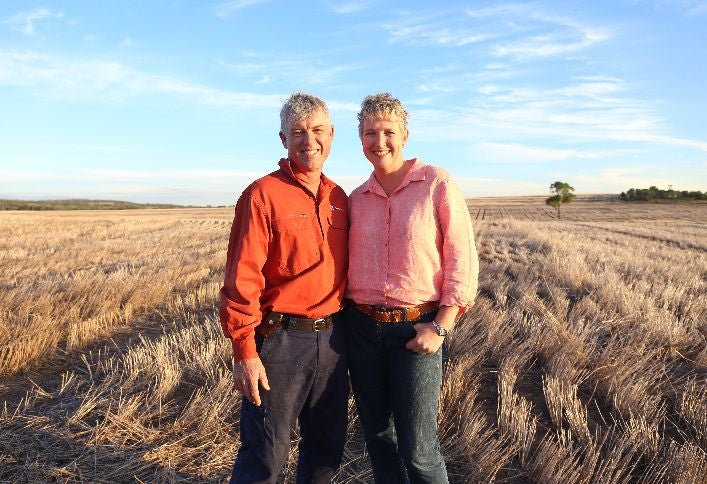Posted by on
20/07/2023
Having grown up on a family farm in North West NSW, Lee Coleman was always passionate about agriculture – and while a corporate career initially side-tracked his rural ambitions, the calling proved too great.
Thirteen years ago Lee, his wife Cassie and three sons Angus, Matthew and Hamish returned to the region in which he grew up, and, armed with fresh eyes, unique insights into business and a thirst for technology, Lee and Cassie are breathing new life into the family farm, and the greater industry.
The grass is greener on the other side
Lee worked as a mechanical engineer for the Pratt family’s Visy Group, based in Brisbane for six years, followed by six years in Tumut, whilst Cassie, a statistician and resource manager, worked in the banking sector.
And although Lee would sneak back to the family farm with the boys at any opportunity, Cassie was not so convinced,
“I knew getting Cassie out here would be a slow burn, so I began investing in some blocks near to the family farm, setting up an opportunity to come back.”
His plan worked, and eventually the lifestyle opportunities the farm business afforded were too great to dismiss.
“I was working 24-7 at a leadership level and I was really struggling with the balance of a young family and work,” Lee said.
Cassie laughs that she once said she’d only move to the farm “when tractors had 10 stacker CD players and cabin televisions” adding that “I really did underestimate technology back in the year 2000!”
“I certainly didn’t envisage a life out here, I grew up in the Hunter Valley where my parents’ managed a vineyard, and moved to Brisbane in my teens to swim competitively, before my work took me down the corporate path,” she explains. “But with the birth of my third son I knew we needed wide open spaces, and I couldn’t deny the farming life was a great opportunity.”
Fresh eyes underpin progression
Lee and Cassie took on Lee’s grandparents’ property initially, before purchasing their additional and nearby home block “Yamboon”, Croppa Creek, eight years ago.
“There were quite a few challenges on the family block, my grandparents were from the depression era, so very frugal, which was reflected across the farm,” he said.
“As such, there was a fairly big fixed asset and equipment rebuild required, and we prioritised a stronger focus on safety – making guards, cattle yards, silos, augers and belts in particular, safer.”
To implement further change, the couple turned their attention to leveraging the technology of modern machinery, improving the average age of equipment on the farm from 15 years to four years.
One of the greatest impacts within their business was the conversion of machinery to uniformed controlled traffic, the last machine to fit their 12 metre system was their header in 2018.
Controlled traffic is a modern farming technique whereby machinery always follows exactly the same path, as determined by high accuracy GPS, thereby restricting compaction to these small zones of the paddock.
“In hindsight we should have done it when we bought our header in 2015, but as this coincided with the purchase of “Yamboon” we had to prioritise capital expenditure,” Lee reflects.
“We also wanted to see if the width would work on this more sloping country before committing.”
From their hilltop glass-filled kitchen window overlooking nearby paddocks, Lee and Cassie can physically see the results of this innovation.
“Our country has responded so well to controlled traffic, production is uniform and our yields have increased.”
“We also now keenly notice paddocks across the district where there’s controlled traffic on spray rigs and where there’s conventional farming and harvest – you can physically see the footprint of the harvest equipment in the multiple passes of that traffic, and the crop performance in these areas is impacted.”
Lee and Cassie also credit their investment in building their silo complex in their first five years to better market their grain as extremely valuable.
“We have 3,900 tonne capacity in sealed silos, which we fill and empty up to three times a year – with another 1,500 tonnes available in sheds and silos,” Cassie said.
“This means we don’t have to pay for storage, and in hindsight, we really should have done more.”
Production on the dryland grain growing operation – which includes wheat, barley, durum, chickpeas and sorghum – is also underpinned by stringent rotations.
This is off the back of the Colemans’ benchmarking through AgriPath, with data demonstrating that strict rotations pay dividends over the long term.
“We were kicked in the backside a few years ago when we used our stubble out of the system to feed cattle during the drought – we leveraged off that too hard and it really hurt us when we came out of the drought and needed that moisture blanket and carbon. There was a lesson in that.”
Continually looking for ways to build resilience into their operation, the Colemans’ are currently experimenting with a seed treated root stimulant, Endofuse, with results so far suggesting more nodules on chick peas as well as benefits in the soil analysis.
“We’re hoping the pay-off will also be a benefit to the durum which runs behind it, which is what we’re aiming to achieve,” Lee said.
For the past few years Lee and Cassie have had each paddock soil tested, to make sure they’re not over or under prescribing fertiliser at a straight rate, which has achieved huge savings of product, and costs.

The purchase of a camera spray rig was also a “no brainer” in hindsight, with Cassie estimating it has saved them 40 – 50 per cent in chemical costs annually.
“Although of course, nothing in farming is that easy and last year we could barely even get it into the paddock it was such a wet year.”
In a collaboration with John Deere, Lee has one of the first protein monitors on his header to enable protein mapping as well as yield mapping to try and prove out and improve the nitrogen map for the paddock.
“It’s new technology so it’s exciting to see where it goes, there’s still a bit of work to do in this space but it’s definitely heading in the right direction,” Lee said.
Embracing opportunities for continual learning
Having recently completed Rabobank’s Carbon Training Workshop, Cassie said reducing emissions was front of mind, and that they’re looking for opportunities and challenges in the space.
“We’re keen to understand what will be required of us in the future, particularly if we’re trying to sell barley to beer brands who claim their beer is carbon neutral – we want to be ready to take the opportunity,” she said.
Lee agreed, and believed there would come a point where the social license as a farmer would require demonstrated carbon reduction or generation each year, also unlocking the potential to sell commodities to the market, packaged with a set of credentials that give it a carbon neutral or carbon reduced footprint, for a better sale point.
“We’re not sure if we’d be looking to sell carbon, or bank it to protect ourselves, but we know that growing crops requires carbon,” Lee explained. “You’re putting inputs in, you’re trying to convert as much sunlight and natural nitrogen into proteins, cereals and fibre – we’re going to have to offset it somewhere.”
Lee and Cassie recently joined over 1,600 fellow farming clients and industry leaders at the Rabobank Farm2Fork Summit, which showcased global and local experts sharing their learnings, personal experience and insights.
Lee, who admits to ‘loving a chat’, said the opportunity to gather and network as an industry and hear from leading farmers was invaluable, and applauded Rabobank on the unique initiative.
“I don’t know any other bank that is proactively cross pollinating their client base while providing an opportunity for them to learn from each other.”
Cassie was also buoyed that as an industry, everyone was striving for the same thing.
“We’re all looking for ways we can farm more efficiently, sustainably and of course profitably, and I’m interested as to where carbon credits will fit in – it was really enlightening to hear from farmers already on this journey.”
“Sustainability is more than just a buzz word, it’s an action word and we’re all going to have to get on board. Some are further along this path than others.”
Simplifying farm data management
Once a reluctant farmer, Cassie is now very much immersed in the business, and the Colemans’ make a united and visionary duo.
However in the early days Cassie found her capacity limited due to the constant data entry requirements of the farm.
“Trying to keep track of grain was exhausting, grain is the biggest area of our business where we can make or lose the most money and I was spending a lot of time entering paper dockets into excel to make sure contracts were fulfilled and we were getting paid the correct amount for what we had delivered.”
Their saviour appeared in the form of Matt Higham, one of Cassie’s family members who would regularly help out on the farm during his university years.

“Later, Matt wanted a tree change from his IT career as a software engineer in Manchester, UK and while we couldn’t offer him a comparative salary, he was staunch that he wanted to work on the farm and enjoy the lifestyle,” Cassie explains.
Within his first few months working on farm, Matt identified a more streamlined approach to the administrative side of the business.
“He hates paperwork as much as I do,” Cassie smiles, explaining she was running numerous farm management apps, and a lot of paper forms, without great success.
“Lee had his jobs list in his top pocket and it was very frustrating because no one else knew what was coming up or what he was thinking, so Matt started putting all the paperwork and jobs into an app so that everyone was on the same page across the farm.”
The next step was the all-important ‘pub test’, and with the app the talk of the local Croppa Creek Sporting Club, neighbours soon came onboard to test the system.
“We put it on the App Store, bugs and all, and it grew from there until the ‘Farmers to Founder Bootcamp’, supported by the GRDC, approached us three years ago, and that really challenged us to question whether this was a hobby or a feasible business.”
FarmSimple has since continued to expand its fit-for-purpose product, and boasts an extensive and impressive client-base.
An office was opened in Tamworth, with Matt moving across to work for FarmSimple full-time, while another developer is based in Western Australia and a sales manager resides in Moree.
“Our two developers work with some really cutting edge clients, and when they come to me and say ‘hey, I think we should do this’, I’m quietly fist pumping under the table because as a farmer I know it will be a really valuable addition to the app,” Lee smiles.
“This really demonstrates that my pain points are similar to the pain points impacting the industry as a whole.”
Acknowledging that farming in Australia is extremely efficient, Lee explains that FarmSimple aims to further improve time efficiency and communication.
“We spend a lot of time on tractors running straight lines, so all of our workforce has a bit of time to look at their phones, so how do you leverage that to put as much information as the operator needs, and get as much information to the back office as they need in that spare time.”
When loading trucks, for example, Lee said dockets go straight into the system, even if coverage is poor, it is in the cloud and the ticket is done with a 30 day payment reminder accompanying it.
The app also ensured the truck capacity aligns exactly with what is in the silo being sold, putting the Coleman’s back in the driver’s seat of how they sell their grain.
Cassie, who runs all the farm administration, said the app had solved a multitude of office challenges
“Before, I wouldn’t know what chemicals had been sprayed on what crops, so I couldn’t fill out vendor declarations without Lee being around, whereas now I have all the spray logs in front of me, as they are being done.”
The app continues to evolve, and includes payslips and HR resources, with the next step into the workplace health and safety, and inductions, space.
“We want to make sure everything is kept in the one place so you can encourage your employees to want to use it,” Cassie said.
In just 13 years Lee and Cassie have built a strong and resilient business, embracing the fork in the road that led them to Croppa Creek.
Cassie now admits she wouldn’t live anywhere else.
“Agriculture is such an exciting industry with so much change and opportunity, I’m very pleased to be part of that.
“All three boys have an interest in ag and have all developed a healthy work ethic, earning their term’s boarding school spending money working on the farm. I think this lifestyle is the greatest gift we could have provided them.”
